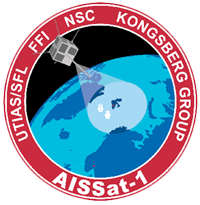
Telemetry is the in situ collection of measurements or other data at remote points and their automatic transmission to receiving equipment (telecommunication) for monitoring. The word is derived from the Greek roots tele, 'remote', and metron, 'measure'. Systems that need external instructions and data to operate require the counterpart of telemetry: telecommand.

An emergency position-indicating radiobeacon (EPIRB) is a type of emergency locator beacon for commercial and recreational boats, a portable, battery-powered radio transmitter used in emergencies to locate boaters in distress and in need of immediate rescue. In the event of an emergency, such as a ship sinking or medical emergency onboard, the transmitter is activated and begins transmitting a continuous 406 MHz distress radio signal, which is used by search-and-rescue teams to quickly locate the emergency and render aid. The signal is detected by satellites operated by an international consortium of rescue services, COSPAS-SARSAT, which can detect emergency beacons anywhere on Earth transmitting on the distress frequency of 406 MHz. The satellites calculate the position or utilize the GPS coordinates of the beacon and quickly passes the information to the appropriate local first responder organization, which performs the search and rescue. As Search and Rescue approach the search areas, they use Direction Finding (DF) equipment to locate the beacon using the 121.5 MHz homing signal, or in newer EPIRBs, the AIS location signal. The basic purpose of this system is to help rescuers find survivors within the so-called "golden day" during which the majority of survivors can usually be saved. The feature distinguishing a modern EPIRB, often called GPIRB, from other types of emergency beacon is that it contains a GPS receiver and broadcasts its position, usually accurate within 100 m (330 ft), to facilitate location. Previous emergency beacons without a GPS can only be localized to within 2 km (1.2 mi) by the COSPAS satellites and relied heavily upon the 121.5 MHz homing signal to pin-point the beacons location as they arrived on scene.

Marine VHF radio is a worldwide system of two way radio transceivers on ships and watercraft used for bidirectional voice communication from ship-to-ship, ship-to-shore, and in certain circumstances ship-to-aircraft. It uses FM channels in the very high frequency (VHF) radio band in the frequency range between 156 and 174 MHz, inclusive, designated by the International Telecommunication Union as the VHF maritime mobile band. In some countries additional channels are used, such as the L and F channels for leisure and fishing vessels in the Nordic countries. Transmitter power is limited to 25 watts, giving them a range of about 100 kilometres.
The Global Maritime Distress and Safety System (GMDSS) is a worldwide system for automated emergency signal communication for ships at sea developed by the United Nations' International Maritime Organization (IMO) as part of the SOLAS Convention.
The David Florida Laboratory is the Canadian Space Agency's spacecraft assembly, integration and testing centre, in Shirleys Bay, just west of central Ottawa. It is operated by the Canadian Space Agency and rented out to Canadian and foreign aerospace and telecommunications companies and organizations for qualifying space bound equipment such as communication or scientific satellites, or components made to be placed on satellites or installed in a space station. The laboratory was named to honour C. David Florida, a leading Canadian pioneer in space research.

A Medium Attachment Unit (MAU) is a transceiver which converts signals on an Ethernet cable to and from Attachment Unit Interface (AUI) signals.

The automatic identification system (AIS) is an automatic tracking system that uses transceivers on ships and is used by vessel traffic services (VTS). When satellites are used to receive AIS signatures, the term Satellite-AIS (S-AIS) is used. AIS information supplements marine radar, which continues to be the primary method of collision avoidance for water transport. Although technically and operationally distinct, the ADS-B system is analogous to AIS and performs a similar function for aircraft.

The International Cospas-Sarsat Programme is a satellite-aided search and rescue (SAR) initiative. It is organized as a treaty-based, nonprofit, intergovernmental, humanitarian cooperative of 45 nations and agencies. It is dedicated to detecting and locating emergency locator radio beacons activated by persons, aircraft or vessels in distress, and forwarding this alert information to authorities that can take action for rescue. Member countries operate a constellation of around 66 satellites orbiting the Earth which carry radio receivers capable of locating an emergency beacon anywhere on Earth transmitting on the Cospas-Sarsat frequency of 406 MHz.
ORBCOMM is an American company that offers industrial internet and machine to machine (M2M) communications hardware, software and services designed to track, monitor, and control fixed and mobile assets in markets including transportation, heavy equipment, maritime, oil and gas, utilities and government. The company provides hardware devices, modems, web applications, and data services delivered over multiple satellite and cellular networks.

AAC SpaceQuest is a spacecraft components and engineering company located in Fairfax, Virginia, which focuses on the operations of small satellites.

A navigational aid (NAVAID), also known as aid to navigation (ATON), is any sort of signal, markers or guidance equipment which aids the traveler in navigation, usually nautical or aviation travel. Common types of such aids include lighthouses, buoys, fog signals, and day beacons.
Monitoring, control and surveillance (MCS), in the context of fisheries, is defined by the Food and Agriculture Organization (FAO) of the United Nations as a broadening of traditional enforcing national rules over fishing, to the support of the broader problem of fisheries management.

Vessel Monitoring Systems (VMS) is a general term to describe systems that are used in commercial fishing to allow environmental and fisheries regulatory organizations to track and monitor the activities of fishing vessels. They are a key part of monitoring control and surveillance (MCS) programs at national and international levels. VMS may be used to monitor vessels in the territorial waters of a country or a subdivision of a country, or in the Exclusive Economic Zones (EEZ) that extend 200 nautical miles (370.4 km) from the coasts of many countries. VMS systems are used to improve the management and sustainability of the marine environment, through ensuring proper fishing practices and the prevention of illegal fishing, and thus protect and enhance the livelihoods of fishermen.

SARAL is a cooperative altimetry technology mission of Indian Space Research Organisation (ISRO) and Centre National d'Études Spatiales (CNES). SARAL performs altimetric measurements designed to study ocean circulation and sea surface elevation.

AISSat-1 is a satellite used to receive Automatic Identification System (AIS) signals. Launched on 12 June 2010 from Satish Dhawan Space Center as a secondary payload, AISSat-1 is in a sun-synchronous low Earth orbit. Initially a development project, the satellite has since passed into ordinary operations. Via downlinks at Svalbard Satellite Station and at Vardø Vessel Traffic Service Centre it tracks vessels in the Norwegian Sea and Barents Sea for the Norwegian Coastal Administration, the Norwegian Coast Guard, the Norwegian Directorate of Fisheries and other public agencies.
LuxSpace is a European space systems contractor based in Betzdorf in Luxembourg. It was founded in November 2004 as a daughter company of OHB AG, and began operations in January 2005.
Maritime domain awareness (MDA) is defined by the International Maritime Organization as the effective understanding of anything associated with the maritime domain that could impact the security, safety, economy, or environment. MDA is said to work as a ‘key enabler’ for other maritime security issues, such as anti-piracy patrols, in the way that in order to do effective patrols you need to have the ability of conducting effective MDA. The maritime domain is defined as all areas and things of, on, under, relating to, adjacent to, or bordering on a sea, ocean, or other navigable waterway, including all maritime-related activities, infrastructure, people, cargo, and vessels and other conveyances.
The Marine Exchange of Alaska (MXAK) is a nonprofit maritime organization based in Juneau, Alaska. MXAK was founded in 2001 by retired United States Coast Guard Captain Edward Page, who along with Paul Fuhs and others in the maritime community established a Governing Board. The organization was established to broker information, that aids safe, secure, efficient, and environmentally sound maritime operations in Alaska. MXAK’s greatest advance in promoting maritime safety has been the establishment, operation and maintenance of an extensive vessel tracking network comprising over 140 Automatic Identification System (AIS) and Marine Safety stations in Alaska, complemented with satellite tracking systems. MXAK also serves the maritime community by assisting vessels, facilities and ports to comply with state and federal environmental, safety, and security regulations, and installing and maintaining weather stations at remote locations across Alaska. The Marine Exchange of Alaska is a presence in local, state, and federal meetings and workshops, advocating for cost effective measures that benefit Alaska and the maritime community.

exactEarth Ltd is a Canadian company that specializes in data services that deliver real-time global location-based maritime vessel tracking information utilizing patented satellite AIS detection technology.
Vardø Vessel Traffic Service Centre, also known as Norwegian Oceanic Region Vessel Traffic Service, is a vessel traffic service situated in the town of Vardø in Vardø, Norway. It is responsible for monitoring ship traffic off the baseline of Norway throughout the exclusive economic zone (EEZ), including the areas around Jan Mayen and Svalbard. It has special responsibilities for the sealanes into Hammerfest and Sveagruva.











